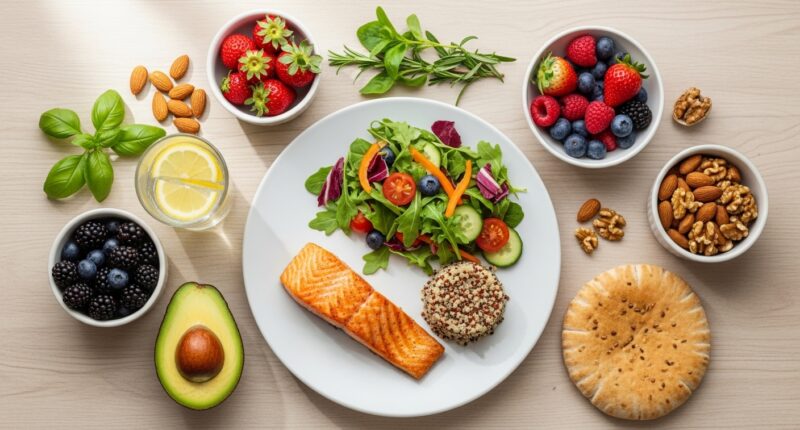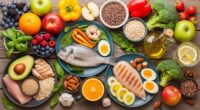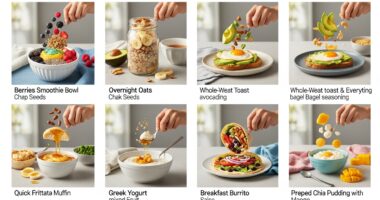Transforming your eating habits doesn’t have to be about drastic deprivation or rigid rules. It’s a journey of adding in nutrient-dense foods that boost your energy, improve your health, and delight your taste buds. By making small, sustainable shifts, you can seamlessly weave healthy foods into your daily meals. This guide provides practical, actionable strategies to help you enrich your diet with the goodness your body deserves.
Start with Small, Sustainable Swaps
Trying to overhaul your entire diet overnight is a recipe for burnout. The most effective approach is to make incremental changes that gradually become lifelong habits.
Upgrade Your Go-To Meals
Look at your current favorite dishes and identify one simple swap. These small changes add up significantly over time without making you feel like you’re on a “diet.”
-
Pasta: Try swapping half of your regular pasta for zucchini noodles (zoodles) or lentil pasta. You’ll barely notice the difference but you’ll get a powerful boost of fiber and nutrients.
-
Rice: Cauliflower rice is a fantastic low-carb alternative. You can buy it pre-riced or make it yourself by pulsing cauliflower florets in a food processor.
-
Sandwiches: For one lunch a week, try using large lettuce leaves (like romaine or butter lettuce) instead of bread for a refreshing and crunchy wrap.
-
Snacks: Instead of reaching for chips, try air-popped popcorn, a handful of nuts, or sliced apple with peanut butter.
The Power of the “Add-In” Method
Rather than focusing on what to remove, focus on what you can add. This positive framework makes healthy eating feel abundant, not restrictive.
-
Soups and Stews: Stir in a handful of spinach or kale in the last few minutes of cooking.
-
Omelets and Scrambles: Add diced peppers, mushrooms, onions, or tomatoes.
-
Smoothies: Blend a handful of spinach into your fruit smoothie. You won’t taste the spinach, but you’ll get a full serving of leafy greens.
-
Yogurt: Mix in berries, a sprinkle of chia seeds, or a tablespoon of flaxseed for added fiber and omega-3s.
Master the Art of Meal Preparation
A little planning is the single biggest factor in dietary success. When healthy food is convenient and readily available, you’re far more likely to eat it.
Plan and Shop with Purpose
Dedicate 20 minutes each week to planning a few key meals. Write a shopping list based on this plan and stick to it. This prevents impulsive, less-healthy purchases and reduces food waste.
Prep Ingredients in Advance
You don’t have to cook full meals. Simply washing and chopping vegetables, cooking a batch of quinoa or brown rice, or hard-boiling a few eggs means healthy components are ready to go for quick assembly during a busy week.
Make Healthy Eating Enjoyable
If healthy food is boring or bland, you won’t stick with it. The key is to make it delicious and satisfying.
Experiment with Herbs and Spices
Salt and butter are common flavor enhancers, but herbs and spices can create incredible depth without the extra sodium and fat. Experiment with cumin, paprika, garlic powder, oregano, basil, rosemary, and turmeric. A simple squeeze of lemon juice can also brighten up steamed vegetables or a salad.
Discover New Cooking Methods
How you cook can make a big difference. Instead of deep-frying, try:
-
Roasting: This caramelizes the natural sugars in vegetables (like broccoli, Brussels sprouts, and carrots), making them sweet and delicious.
-
Air Frying: Creates a crispy, fried-like texture with a fraction of the oil.
-
Sautéing: Use low-sodium broth or water instead of oil to sauté greens and onions.
Navigate Challenges and Stay on Track
Life is busy, and obstacles are inevitable. Having a plan for challenges will keep you moving forward.
Smart Strategies for Dining Out
Restaurant meals are often oversized and high in hidden fats and sodium. Navigate menus wisely:
-
Look for keywords like “grilled,” “baked,” “steamed,” or “roasted.”
-
Ask for dressings and sauces on the side.
-
Start with a side salad or a broth-based soup to help you feel fuller before the main course.
-
Don’t be afraid to customize your order.
Listen to Your Body
Pay attention to how different foods make you feel. Do you feel energized and satisfied after a meal packed with vegetables and lean protein? Or sluggish and bloated after a processed meal? This mindfulness reinforces why you’re making these changes and helps you intuitively choose foods that make you feel your best.
Conclusion
Incorporating healthy foods into your diet is a marathon, not a sprint. It’s about progress, not perfection. Celebrate your small victories, be patient with yourself, and remember that every healthy bite is a step toward a more vibrant you. By starting small, planning ahead, making it enjoyable, and navigating challenges gracefully, you can build a sustainable and delicious healthy eating pattern that lasts a lifetime.









